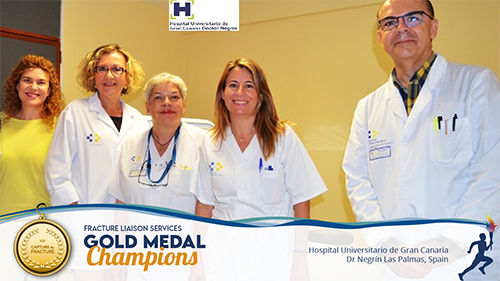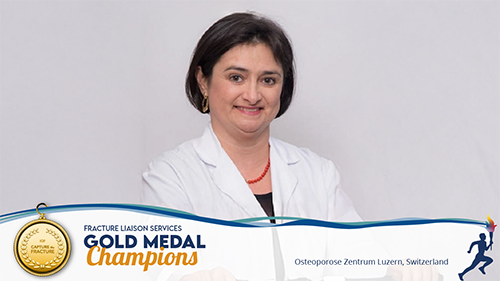Going for Gold in Europe!

Capture the Fracture highlights champions in secondary fracture prevention
Seven gold-standard Fracture Liaison Services (FLS) in Europe have participated in a campaign launched by the International Osteoporosis Foundation’s Capture the Fracture® (CTF) programme to share insights and to inspire FLS services around the world to ‘go for gold’.
While the world was watching the highest level of athletic achievement at the 2024 Summer Olympics in Paris, other champions around the world were performing at Gold-Medal levels of fracture care and prevention. Through their expertise and extraordinary commitment to secondary fracture prevention, these gold-level Fracture Liaison Services (FLS) have achieved the highest standards of post-fracture care for their patients, as assessed by the Capture the Fracture® (CTF) Best Practice Framework.
Eighteen of the 120 Gold-level FLS within the CTF network, which comprises more than 1000 FLS worldwide, responded to a call for participation in a campaign launched for World Osteoporosis Day – nine from the Asia Pacific, seven from Europe, and two from Latin America. The campaign aims to celebrate hospitals achieving the highest level of care according to international standards, while raising awareness of the urgent need for accessible gold-standard care for all patients who suffer a fragility fracture. Everyone wins with gold-standard fracture care and prevention!
IOF thanks the following contributing FLS in the Asia Pacific for their insights about key strategies needed to reach gold-standard level of care:
Presidio Ospedaliero San Giuseppe Moscati, Aversa, Italy
The FLS of the Presidio Ospedaliero San Giuseppe Moscati sees more than 500 patients each year, and has been designated a Gold-level service by Capture the Fracture® since 2021. The FLS is managed by the Orthopaedic-trauma Unit.
“Our FLS follows the following protocol for primary osteoporosis: Identification and enrollment of all patients over 50 who develop a new fragility fracture; conducting radiological examinations and first-level blood tests to assess fragility risk and assessing for falls risk; providing appropriate support and information about osteoporosis; initiating a therapeutic protocol with constant follow-up, including support through telemedicine. For secondary osteoporosis, specifically for patients with a fragility fracture, particularly hip fractures, our protocol includes: enrolment in the FSL Database with the creation of an electronic file for an appropriate pharmacological therapeutic protocol, or, in case of imminent re-fracture risk, treatment with L.O.E.P.; follow-up of enrolled patients to monitor adherence to the therapeutic plan.”

Badalona Serveis Assistencials, Badalona, Spain
The Badalona Serveis Assistencials FLS is an integrated healthcare organization, which was set up in order to provide effective assistance and to respond to peoples’ needs in the territory of Barcelonès Nord, including Badalona, a town that lies 6 miles away from Barcelona. The FLS achieved Gold standard in 2015 and sees approximately 180 patients per year, managing all fracture types. Dr José Manuel Cancio Trujillo (geriatric specialist) is one of the mentors and is actively involved in the management of this FLS , which involves several multidisciplinary teams:
“The fracture liaison service activity in our organization involves several teams led by the Department of Geriatrics. Our main objective is to provide a continuity of care to frail older patients with osteoporotic fractures, from the acute and post-acute phases to post-discharge follow-up. After reinsertion into the community, all patients are regularly followed by multidisciplinary staff of the orthogeriatric unit (outpatient care) in order to complete diagnostics and treatment with the objectives of preventing new fractures and maintaining physical function. Our team ensures therapeutic adherence throughout the life of our patients who have already suffered a fragility fracture, to avoid new fractures, avoid an increase in comorbidities, dependency, fragility and mortality.”
Hospital Universitari de Bellvitge, l'Hospitalet de Llobregat, Spain
The FLS of the Hospital Universitari de Bellvitge was recognized as a gold-level service in 2016. The service sees approximately 550 patients each year and manages all fracture types. Dr Carmen Gómez Vaquero, FLS lead, notes:

“What initially began as a challenge to achieve the gold standard of care has now become our way of working. We feel that to achieve success, the best approach is identifying the highest possible number of patients with fragility fractures as early as possible, ensuring timely intervention. We believe that our efforts are truly helping to reduce the number of fractures in our population, and that is the best reward we could ask for. This motivates us to keep improving how we care for our patients.”

Hospital Universitario de Gran Canaria Dr Negrín, Las Palmas, Spain
The Hospital Universitario de Gran Canaria Dr Negrín FLS achieved Gold in 2014. The public district hospital serves a population of around 400,000 people and the FLS manages approximately 550 patients per year and all fracture types. The service collaborates with 21 primary care centres (255 primary care doctors) as well as with rheumatology, orthopedic and geriatric specialists. Dr Antonio Naranjo Hernández, Adjunct Physician in Rheumatology, is a Capture the Fracture® mentor and is actively involved in the management of this FLS along with Dr. Soledad Ojeda, Rheumatologist.
“To achieve excellence, we believe it is essential to ensure that our actions make sense. Quality secondary fracture prevention relies on honest and humble work, with a focus on the broader healthcare system, not just the hospital. Collaboration among professionals is key to the success of an FLS.”
Center of Bone Diseases, Lausanne University Hospital CHUV, Lausanne, Switzerland
The CHUV FLS achieved Gold in 2013 and was the first FLS from Switzerland to achieve this milestone. The FLS manages approximately 650 patients per year and all fracture types. Lead clinician Prof. Berengere Aubry-Rozier, rheumatologist, says:
"Believing that secondary fracture prevention is imperative to improve patients health management is the motor to achieve a Gold Medal. Not only the FLS coordinator, but the whole team of surgeons, clinical doctors, densitometry technicians, and nurses, has to be involved to reach the goal. Being convinced of the importance of post-fracture care and secondary fracture prevention helps also the patients to believe that being treated is necessary, so they attend the proposed medical appointments."
Osteoporose Zentrum Luzern, Lucern, Switzerland
The Osteoporosis Zentrum Luzern, part of the Clinic Hirslanden, has been a Gold-level service since 2020. It see approximately 670 patients (all fracture types) each year, with the goal of improving care patient care and secondary fracture prevention.

“Using multiple pathways simultaneously (e.g. reaching out to patients for post-fracture treatment, to colleagues for collaboration, to IT systems for data collection, to the hospital director with a business plan) and perseverance helped us the most to get to the goal and reach the gold standard. Quality post-fracture care and secondary fracture prevention equates to a relevant, better quality of life and a significant reduction of further fractures in patients who already have suffered a fragility fracture.”

West Glasgow ACH, Glasgow, UK
West Glasgow ACH, formerly the Western Infirmary which closed in 2015, joined the Capture the Fracture® network in 2020. Among the strategies to reach its Gold standard level of service the FLS uses a specifically designed fracture identification database (Redstar) to identify patients with fractures quickly and to develop a management plan which may include a DXA scan and bone protective treatment. This allows the FLS to identify the right patients at the right time to deliver the right treatment plan.
“Early equitable access to osteoporosis assessment and treatment is vital to reduce the risk of subsequent fractures. We ensure that in West Glasgow this happens!”